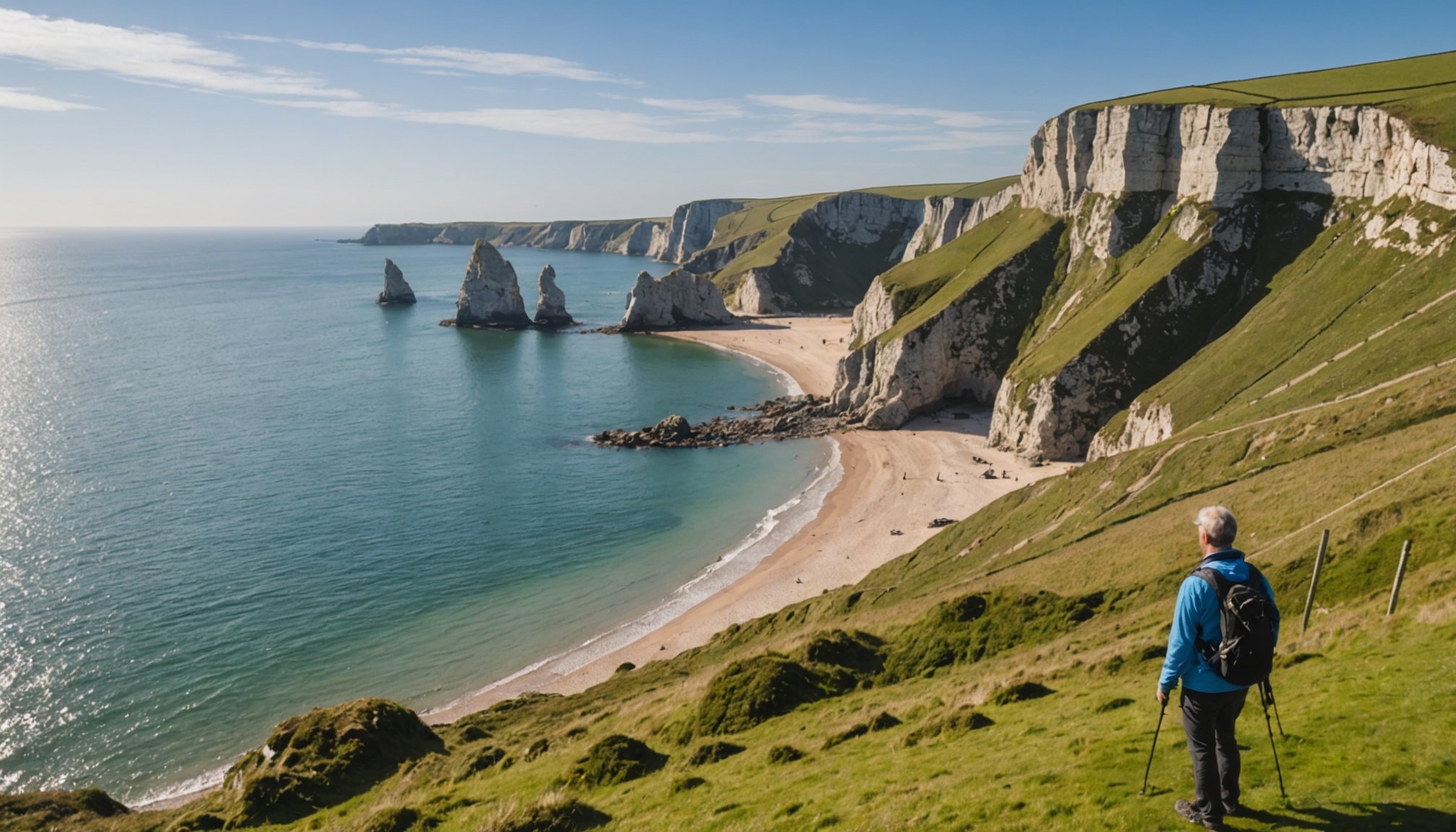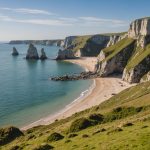Overview of the Jurassic Coast
The Jurassic Coast is a uniquely fascinating destination, renowned for its geological significance and rich historical context. Stretching along the southeastern coast of England for about 96 miles, it presents a remarkable chronicle of Earth’s history, offering insights dating back over 185 million years.
Geologically, the region is a treasure trove, presenting a sequential exposure of Triassic, Jurassic, and Cretaceous rock formations. Visitors can explore fossil-filled cliffs and beaches that reveal extinct species and ancient environments. Among the noteworthy fossils are ammonites and ichthyosaurs, capturing imaginations of budding palaeontologists and tourists alike.
Topic to read : Discovering Cardiff’s Traditional Welsh Music: Your Ultimate Guide to Its Rich Cultural Legacy
Achieving the status of a UNESCO World Heritage Site in 2001, the Jurassic Coast is celebrated for its outstanding universal value. This designation was warranted by its diverse geomorphology and profound contribution to the understanding of earth sciences. Key features include the iconic limestone arch of Durdle Door and the circular bay of Lulworth Cove, both symbols of this natural phenomenon.
As a testament to its significance, the Jurassic Coast continues to be a beacon for education and conservation, fostering global appreciation for geological and environmental heritage.
Also to see : Discovering the Timeless Brontë Sisters: An Enchanting Expedition Through Haworth’s Literary Legacy
Planning Your Walking Tour
Planning a walking tour along the Jurassic Coast offers an enriching experience steeped in natural beauty and historical wonders. To make the most of your exploration, weather and crowd considerations are crucial. The best times to visit are during the shoulder seasons of spring and autumn, when the climate is mild, and there are fewer tourists.
Tailor your itinerary based on your available time. For those with a day, opt for trails like the ones around Lulworth Cove, offering a snapshot of the coast’s allure. A weekend will allow exploration of more significant stretches, like the famous South West Coast Path, renowned for its breathtaking views and diverse terrain. Those planning a longer stay can dedicate a full week to immerse themselves fully.
Preparation is key for a successful tour. Essentials include robust walking shoes, layered clothing, and a reusable water bottle. Don’t forget a map or GPS device to navigate the trails. Understanding the tide times and weather forecasts will enhance your safety and enjoyment. By preparing adequately, you can ensure a memorable journey along this extraordinary coastal trail.
Suggested Walking Routes
Embarking on the South West Coast Path is ideal for experiencing the Jurassic Coast’s geological wonders. Starting from Lyme Regis, the path leads to the iconic Golden Cap, offering panoramic views of the coastline. This trail caters to various abilities and rewards walkers with spectacular scenery.
Iconic Trails
The South West Coast Path stretches for about 630 miles but offers sections that showcase stunning geological features. From the fossil-rich Charmouth beach to the dramatic cliffs of Beer Head, each segment promises awe-inspiring vistas. Accessibility varies, with some trails providing easier access, while others challenge more seasoned hikers.
Hidden Gems
For those seeking solitude, trails like the Abbotsbury Swannery Path provide a serene escape amid nature. These lesser-known routes offer unique perspectives and abundant photo opportunities, far from the bustling tourist spots. Remember to pack a camera for capturing these picturesque landscapes.
Ensure you’re prepared by checking local maps and guides, as these routes might not be fully marked. This adventure off the beaten path promises unmatched tranquility and a deeper connection with the captivating surroundings of the Jurassic Coast.
Points of Interest Along the Coast
The Jurassic Coast is home to several noteworthy attractions, each offering a glimpse into its geological and historical significance. Prime among these is Durdle Door, a natural limestone arch that captivates visitors with its unique formation, reminiscent of the coastal processes that shaped this iconic site. Nearby, Lulworth Cove enchants with its perfectly circular bay, illustrating the dynamic natural forces at play.
In addition to these stunning natural landmarks, the coast is steeped in history. Historical sites, such as ancient fortifications and remnants from the past, add depth to any walking tour. Their stories provide context and understanding of the region’s enduring appeal and strategic importance throughout history.
Museums and visitor centres along the coast offer an enriching perspective on the area’s past. Integrating these stops into your itinerary not only enhances your appreciation of the region’s heritage but also offers a convenient educational break. Be sure to immerse yourself in both the breathtaking beauty and the rich history that the Jurassic Coast.
Flora and Fauna of the Jurassic Coast
As you traverse the Jurassic Coast, prepare to be captivated by its rich tapestry of wildlife observation opportunities. This unique region boasts a diverse array of local ecosystems, supporting an impressive variety of species.
Amidst the cliffs and shores, keen wildlife enthusiasts can spot peregrine falcons swooping above or catch a glimpse of rare greater horseshoe bats in the twilight. The intertidal zones teem with marine life; rock pools bustle with crabs, starfish, and anemones, offering a wonderful spectacle for nature spotting.
The coast’s landscapes encompass a range of habitats, from rugged clifftops to tranquil estuaries, each fostering distinct ecosystems. These varied environments play host to numerous birds, mammals, and insects that thrive in their respective niches.
While observing the natural wonders, it’s vital to practise safe and responsible wildlife viewing. Maintain a respectful distance from animals, use binoculars for a closer look, and stick to designated paths to protect both the wildlife and their habitats. Respecting the natural environment ensures that future generations can continue to enjoy the stunning biodiversity of the Jurassic Coast.
Safety Considerations
Embarking on a journey along the Jurassic Coast requires safety tips tailored for its unique landscape. Being mindful of tides is crucial; always check tide times before heading out, as certain paths might become inaccessible. Additionally, the towering cliffs necessitate caution; keep a safe distance from the edges, as erosion can make them unstable.
Weather can be unpredictable along the coast. Prepare for changing conditions by wearing appropriate clothing and carrying rain gear. Staying informed via weather forecasts minimises risks, ensuring you’re guarded against unexpected shifts.
In case of emergencies, knowing local emergency services is essential. The coast’s remoteness in some areas might lead to delayed assistance, so carrying a fully charged mobile phone is advisable. In dire situations, dial 999 for immediate help.
Be proactive in protecting your wellbeing by sharing itinerary details with someone not on the tour. This simple step can aid emergency contacts should problems arise. With thoughtful preparation, your experience on the Jurassic Coast can be safe and enjoyable, letting you fully appreciate its natural and historical splendour.
Accommodations and Dining Options
When exploring the Jurassic Coast, finding the right accommodation and dining options can enrich your experience. The area offers a range of lodging choices, including charming bed and breakfasts, cosy hotels, and scenic campsites. For those seeking comfort after a long day of walking, options like The Priory Hotel offer a relaxing stay with stunning pastoral views. Meanwhile, campsites such as Sea Barn Farm provide a more rustic experience, blending nature with basic amenities.
Dining along the coast features a delightful mix of local restaurants and cafes. The Hive Beach Café is famed for its fresh seafood, offering dishes that highlight the region’s maritime bounty. Alternatively, The Crab House Café provides a quintessential coastal dining experience with its laid-back atmosphere and stunning sea vistas.
Visitor services and amenities are conveniently located near main walking routes and attractions. Towns like Swanage and Lyme Regis house numerous options within walking distance, making logistics simple for travellers. Whether you’re ending your day with a comfortable bed or a delicious meal, the Jurassic Coast’s accommodation and dining options enhance the diversity and enjoyment of your journey.
Personal Anecdotes and Testimonials
Exploring the Jurassic Coast often leaves visitors with rich experiences and unforgettable memories. Many have shared their personal stories, recounting the beauty of the geological formations and the thrill of discovering fossils along the beach. The diverse landscape, from sprawling cliffs to serene bays, offers an iconic backdrop for these adventures.
One visitor recalls their amazement upon seeing Durdle Door for the first time, describing it as a natural masterpiece. The excursion not only provided stunning views but also a sense of connection to the prehistoric world. Another traveller praised the UNESCO World Heritage Site status, noting how it highlighted the area’s global importance and spurred their interest in earth sciences.
Testimonials frequently mention the warmth of local communities and the enjoyable balance between natural exploration and cultural immersion. Local landmarks such as Lulworth Cove, paired with insightful museum visits, enrich the experience further.
Encouraged by these tales, many visitors feel inspired to return and further explore the Jurassic Coast, adding their own stories to the growing tapestry. If you’ve experienced the coast, your insights and tips could provide guidance and inspiration for future explorers eager to discover this unique destination.











